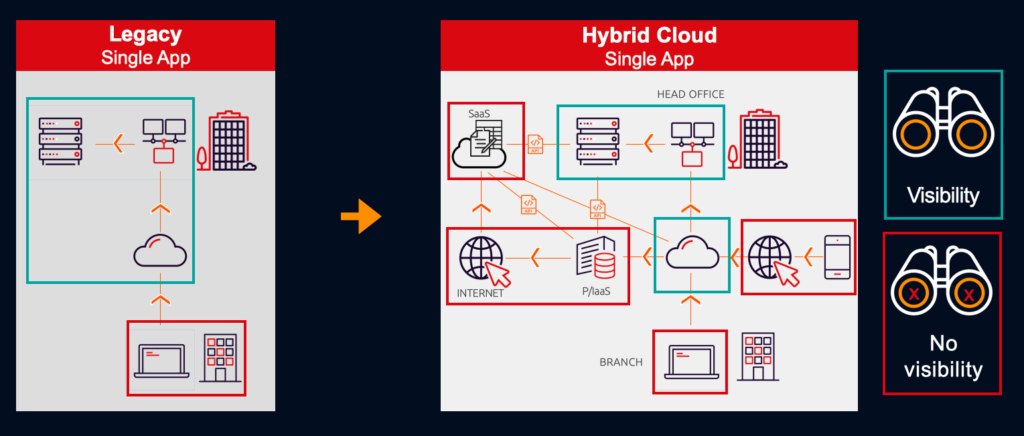When looking at the current enterprise landscape, some of the more pronounced trends in Application Performance Monitoring (APM) may not come as a surprise, yet they are worth reinforcing. One of the more obvious trends is the move from technical KPIs to end user experience (EUE) metrics and cohesive business level indicators that actually connect user experience with the organization’s bottom line. Clearly, APM solutions needs to detect and diagnose complex, end-to-end application performance problems effectively and efficiently to maintain outstanding EUE at the level that users have come to expect.
The increasing adoption of Software-as-a-Service (SaaS) has also been impacting IT organizations in a big way recently. With the continuing rise of SaaS, SaaS performance monitoring specifically has become a key priority for IT departments who are faced with finding the best ways to troubleshoot the performance of these applications quickly. Currently, organizations do not necessarily inspect data as it moves in and out of the network which creates a number of challenges, like encryption, especially around the SaaS and Cloud-hosted applications such as Office 365, Google Suite, and Salesforce. IT departments are discovering that while there are certainly cases where they need the original packets for full visibility into the network, TCP transport, and application performance, there are also many times when crunching large volumes of packets negatively affects problem isolation and resolution time. There is a need to find a way to win back transaction visibility and accelerated root cause analysis without the complexity and time-consuming and cost-consuming inefficiencies associated with current methods.

Then, there are the major changes that are happening directly in the data center: for example, Private Clouds which requires a new architecture to bring software-defined networking (SDN) to data centers whose performance management instrumentation is designed for physical networks and traffic capture tools. And, there is the rise of container-based technologies in the enterprise where software needs to run reliably when moved from one computing environment to another, plus the more common adoption of private and public cloud platforms. And on top of SDN in data centers and containerization, IT organizations need the basic ability to track application performance and need to be able to migrate applications and data to the most appropriate service based on latency, compliance, and cost concerns. How is there still a gap here?
So, what is the response to these trends?
Certainly, with the inescapable transition to cloud and hybrid environments, where much of the infrastructure is not owned, Performance Monitoring is inherently critical to deliver satisfactory IT services, as well as to meet end-user service expectations and even contracted agreements. Some of the most fundamental requirements for buyers in the APM marketplace include finding solutions that accelerate resolution or Mean Time to Revenue (MTTR).
In this context, MTTR remains a priority. Satisfactory IT services calls for moving away from silo-based monitoring, shortened MTTR and a move to more collaboration across silos and with external vendors. Fault isolation across networks, datacenter infrastructure and applications is of course a priority. But sharing information across IT silos to drive optimization is another significant point of interest.
Another vital requirement that buyers of APM solutions should look for visibility in monitoring East-West traffic and not just North-South. With the majority of today’s servers residing in primarily virtualized environments, there is a clear need for deeper application performance troubleshooting. East-West traffic monitoring can give IT operations more visibility up and down the entire application chain and across the network and will help minimize degradations, errors, and time delays.
Finally, understanding their own infrastructure and application dependencies before moving them to a public cloud platform has become a major goal for IT organizations contemplating a “cloud first” strategy and “application performance baselining” is a key part of that. It is important to conduct a complete mapping of critical applications and establish a baseline for each application’s performance. By this we mean, what are the normal behaviors between the client and the front-end server, as well as the front-end-server and the back-end server?
But, having said all that, not all industry solution providers are created equal. Some industry solutions lack critical Application Performance Monitoring functionality. For example, traditional Network Performance Monitoring and Diagnostics (NPMD) vendors have struggled with East-West traffic capture in new environments like SDNs, public cloud and containerized environments. As we discussed above, these environments require a new approach to traffic analysis – moving away from traditional centralized traffic capture to distributing capture capabilities. In addition, the instrumentation across on-premise data centers and public cloud will be strongly required but will be highly cost sensitive.
In summary, the trends we see include: a sharper focus on business level indicators around end user experience, a data center evolution that includes the rise of container-based technologies and SDN, and a significant adoption of SaaS, making SaaS performance monitoring a key priority for IT operations. To respond to these trends, fundamental requirements for buyers in the APM marketplace should include solutions that shorten MTTR and drive more collaboration across silos, as well as addressing East-West traffic monitoring. If you have that covered, you’re off to a great start. Solutions need to offer functionalities that support new hybrid environments, moving away from traditional centralized traffic capture to distributing capture capabilities.

 Improved delivery, better visibility: How Accedian and VMware are working together to help CSPs navigate the 5G world
Improved delivery, better visibility: How Accedian and VMware are working together to help CSPs navigate the 5G world
 Adding a new dimension of visibility to the Cisco Full-Stack Observability portfolio with Accedian Skylight
Adding a new dimension of visibility to the Cisco Full-Stack Observability portfolio with Accedian Skylight